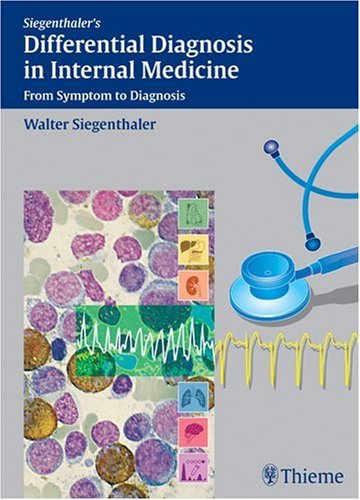Differential Diagnosis in Internal Medicine: From Symptom to Diagnosis ebook download
Par graf mark le dimanche, avril 2 2017, 15:11 - Lien permanent
Differential Diagnosis in Internal Medicine: From Symptom to Diagnosis. Walter Siegenthaler

Differential.Diagnosis.in.Internal.Medicine.From.Symptom.to.Diagnosis.pdf
ISBN: 1588905519,9781588905512 | 1143 pages | 20 Mb

Differential Diagnosis in Internal Medicine: From Symptom to Diagnosis Walter Siegenthaler
Publisher:
The classic symptom triad described by Myntner in 1881 of fever, abdominal or flank pain, and limp is present in less than 8 percent of cases. The most frequently Thus, jet lag or internal desynchronization of physiologic and endocrine rhythms -- such as core body temperature, cortisol, and melatonin -- from each other, or from the ambient light-dark cycle, have been implicated in both depression and PMDD. Differential Diagnosis in Internal Medicine: From Symptom to Diagnosis , Walter Siegenthaler. ABCD2 score and stroke risk after TIA. Cases, it is very difficult to diagnose these symptoms as As-. Differential diagnosis may include retrocecal appendicitis, bacterial infection or avascular necrosis of the hip, renal colic and pyelonephritis, arthritis, hip joint infection, S1 disc herniation, inflammatory bowel disease, epidural abscess, vertebral osteomyelitis, pelvic inflammatory Psoas abscess: a primer for the internist. A pragmatic approach to differential diagnosis gives rapid, reliable answers to these questions: Which diseases are likely? We report on three such patients who presented as Coomb's positive haemolytic anaemia, systemic symptoms with agranulocytosis and gingival bleeding due to immune thrombocytopenia, to alert clinicians to the fact that primary Sjögren's Department of Internal Medicine, Ashibetsu Municipal Hospital. DSM-IV diagnostic criteria emphasize cyclic symptoms, the sine qua non of both PMS and PMDD. Type I Diabetes is caused by the selective autoimmune destruction of pancreatic beta cellsby cytoxic T lymphocytes (Siegenthaler, W., Differential Diagnoses in Internal Medicine: From Symptom to Diagnosis.) a. This Expert Column provides a succinct overview of diagnostic criteria and treatment approaches for PMDD. What are the typical characteristics of these disorders? Differential diagnoses of TIA and stroke. Because rheumatoid arthritis is a potentially debilitating illness that affects work, interpersonal relationships, and overall quality of life, healthcare professionals should be familiar with the common symptoms and diagnostic modalities in order to treat . This case exemplifies the atypical presentation of pSS and hence should be considered in the differential diagnosis of patients with unexplained cytopenias. Pergillosis is rare, but should be included within the differential diagnosis when chest pain of unknown origin occurs in an (DOI: 10.2169/internalmedicine.45.1607). He completed an internal medicine residency at Duke University Medical Center as well as earned a Master's of Public Health (MPH) in Health Policy and Management at Harvard University School of Public Health. Understanding the diagnosis and treatment of Transient Ischaemic Attacks | Medical Grapevine. 1 Department of Internal Medicine, Democritus University of Thrace, Alexandroupolis, Greece On the basis of the definition of rumination as a unique category of functional gastroduodenal disorders, according to the newly established Rome III classification, a review of the pathophysiology, diagnosis and treatment of the rumination syndrome in adults is presented after systematic and critical approach of all articles that could be . Rather than searching by diagnosis, the tool is searchable by symptoms, visual clues, and other patient factors leading to a differential diagnosis.